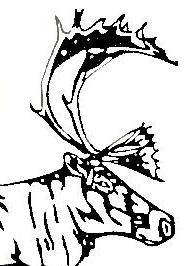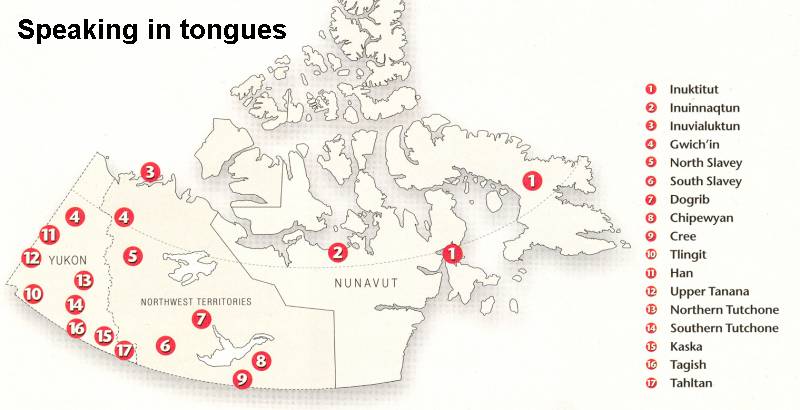News from the North
And there sat Sam, looking cool and calm,
in the heart of the furnace roar;
And he wore a smile you could see a mile,
and he said, "Please close that door.
It's fine in here, but I greatly fear
you'll let in the cold and storm-
Since I left Plumtree, down in Tennessee,
it's the first time I've been warm".
There are strange things done in the midnight sun
By the men who moil for gold;
The Arctic trails have their secret tales
That would make your blood run cold;
The Northern Lights have seen queer sights,
But the queerest they ever did see
Was that night on the marge of Lake Lebarge
I cremated Sam McGee
The Cremation of Sam McGee by Robert Service
| Cette page a pour objet de présenter des
articles qui concernent
la vie quotidienne, l'histoire et l'actualité de l'arctique. Ces
articles peuvent être rédigés en Francais ou en
Anglais,
et sont publiés avec l'accord de leurs auteurs. |
1. THE GWITH'IN ATHAPASKAN LANGUAGE
2. SPEAKING IN TONGUES
 |
1. The Gwitch'in Athapaskan language
The Gwich'in Athapaskan language has also been
known as Loucheux, Kutchin
and Tukudh. It is used in Northern Yukon, Northeast Alaska and
Northeast
N.W.T. The people of the Gwich'in community of Old Crow call themselves
the Van Tat-Gwich'in, or people who live among the lakes (ie., Crow
Flats)"
(The language is referred to as Kutchin, or Tukudh.) Settlements are
Fort
Yukon, Chalkyitsik, Birch-Creek, Venetie and Arctic Village.
Other speakers live in the North West
Territories: Aklavik, Inuvik,
Arctic Red River and Fort McPherson. The Gwich'in Language has been
taught
in the Chief Zzeh Gittlit School in Old Crow since the early 1970's.
The
current instructors are Mrs. Helen Charlie and Mrs. Annie Lord.
Gwich'in
classes are attended by virtually all the students during the year.
|
Authorisation : Old
Crow Website.
To learn more visit : http://www.oldcrow.yk.net
The first writing system for the Gwich'in or Tukudh language was
created
by Archdeacon, Robert McDonald (1829-1913), a church of England
missionary
who began working with the Gwich'in people in the 1860's. With the help
of the Gwich'in people, McDonald translated the entire Bible, the book
of Common Prayer, and a book of Takudh Hymns. These books are still
being
used today by middle-aged and older people who were taught to read and
write the McDonald alphabet. Most of the younger people have a
difficult
time reading the materials because the symbols used by McDonald were
inconsistent.
Today young people can rely on a modern writing
system that reflects
more accurately and consistently which was developed by Richard
Mueller,
a linguist and Bible translator. The Mueller alphabet for Alaskan
Loucheux
was adapted by the Yukon Native Language Centre since the mid 1970's
for
use in writing the Canadian dialects of the language.
Examples
How are You?.................Neenjit
dàgòonch'uu?
I am fine..................................Sheenjit
gwiinzii.
How about you?.................................Nanh
yu'?
Me too, I'm fine....... Shint'eh sheenjit
gwiinzii.
How is he/she?................Veenjit
dàgòonch'uu?
He/she is fine............................Veenjit
gwiinzii.
I live in Old Crow................Old
Crow gwihch'ii.
Who is this?.............................Jii
jùu t'iinch'uu?
This is my mother.............Jii
shihanh t'iinch'uu.
This is my father...................Jii shiti'
t'iinch'uu.
This is my grandmother....Jii
shitsuu t'iinch'uu.
This is my grandfather........Jii
shitsii t'iinch'uu.
Copyright © 1999 Vuntut Gwitchin First Nation |

 |
| The North is home to two dozen aboriginial
languages, from those
in Athapaskan family (most of the Yukon's 14 languages and many of the
NWT's) to those rooted in the history of the Inuit.
The occasional pocket of other first nations'
tongues, such as Tlingit
in the Yukon and Cree in the NWT, have also contributed to the rich
linguistic
heritage of the North.
Nunavut is more homogeneous than its western
neighbours, with its
inhabitants speaking one of the many dialects of Inuktitut, such as
Inuinnaqtun
of the Arctic Coast.
But the map tells the story better. Use it to
check out where the
various languages are spoken in the lands North of 60°.
Credit : Up
Here Magazine : http://uphere.ca
|


|


